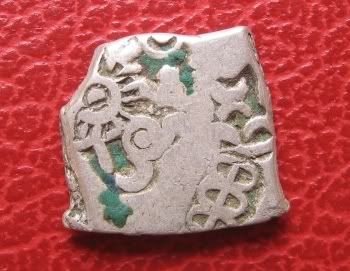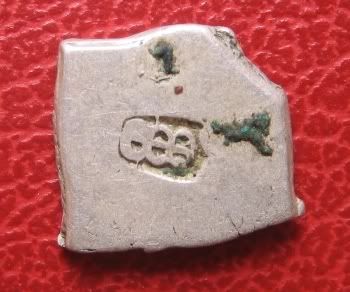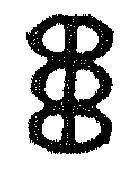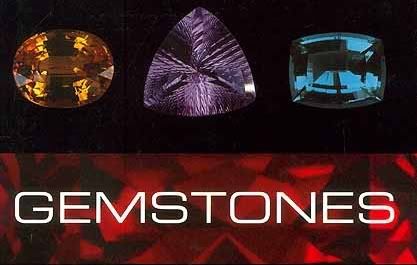http://en.wikipedia.org/wiki/Ashoka_the_great
Another link, for those who love conspiracy theories:
http://en.wikipedia.org/wiki/Nine_Unknown_Men
Obverse


Reverse

Symbols
Obverse

Five symbols:
1. Sun
2. Sadaracakra (dynasty wheel) or Dharmacakra (Wheel of Dharma) (type uncertain)
http://en.wikipedia.org/wiki/Dharmacakra
3. Caduceus (Ashoka's royal symbol)
http://en.wikipedia.org/wiki/Caduceus
4. Three-arched hill
5. Triskeles and unknown symbol
http://en.wikipedia.org/wiki/Triskelion
Reverse
Ashoka's mudra (Caduceus)

Note: The caduceus (depicted as three ovals crossed by a line) can also be found on older punch-marked coins. However, Ashoka's signet has ovals that touch each other, which is not the case in the symbol found on older coins.
General information on punch-marked coins:
Shape:
Chandragupta Maurya's Prime Minister Kautilya (also known as Chanakya) describes in his book Arthashastra how the coins of this period were made. The metal was melted, purified with alkalies, beaten into sheets, and cut into pieces. Subsequently, the symbols were punched on these pieces. Since the pieces had to be cut and clipped to make them conform to a particular weight, coins were made in all kinds of shapes and sizes. Sometimes, metal of the desired weight was melted and either poured on a flat board to take its own shape or made into pellets, which were then flattened.
Symbols:
Initially, the coins carried only one symbol. Gradually, the number of symbols increased to two, and then five. If the coin bore a single symbol, it was placed at the center of the flan. If there were two symbols, they were placed side by side. Four symbols were usually placed in pairs (one pair opposite the other).
The flan of the coin was often much smaller than the size of the punches. Therefore, in coins with four or five symbols (such as the one I have posted), it is common to find parts of the symbols off the flan or overlapping one another. These factors (coupled with the astounding varity of the symbols) often make the correct identification of the symbols very challenging.
Originally, the symbols were punched only on one side of the coin (which may be called the obverse). When the coin became worn, a fresh symbol (or group of symbols) was pressed on the reverse. For coins bearing four or five symbols, the reverse was either blank or bore minute symbols (mostly one or two in number), which are believed to be those of shroffs or money testers. Coins of later period (bearing five obverse symbols) carried a conpicuous symbol on the center of the reverse, which became quite bold during the Mauryan period.
Coins of Magadha (the seat of the powerful Maurya dynasty) can be divided into two periods.
1. Earlier issues of the time when Magadha was merely a janapada (small state):
These can again be divided into two sub-periods.
(a) The period during which Rajagriha was the capital: Coins of this period are of an irregular, roughly rectangular shape. The number of symbols on them varies from one to six.
(b) Coins issued after the capital was shifted to Patliputra (Patna): These coins bear four symbols, of which two are the sun and the six-armed symbol (Sadaracakra). The earlier coins of this period are irregular, and the later ones circular.
2. Coins issued during the period of Magadha's imperial expansion: Thin, broad coins are thought to be earliest in chronology and the thick, smaller ones latest. These coins are found in a variety of shapes, all of which have five different symbols on the obverse, placed in a definite order. More than 450 varieties of these symbols can be identified on these coins! Based on the symbol groups, the coins can be classifed into about 600 varieties, which can be sub-divided into various classes and, in turn, into six or seven series.
Coins of the first four series bear minute symbols on the reverse. Coins of series five bear a distinct mark on the reverse, in addition to these minute marks. Coins of series six and seven have a reverse mark as bold as the obverse symbols.







